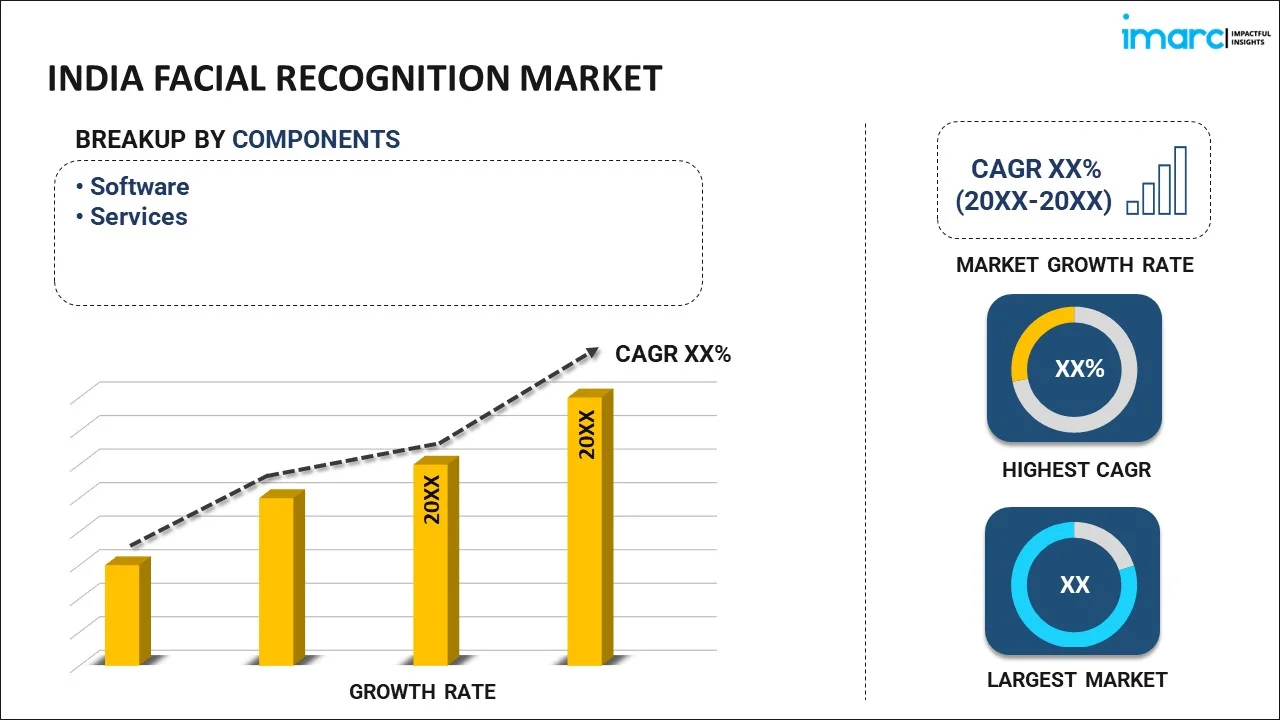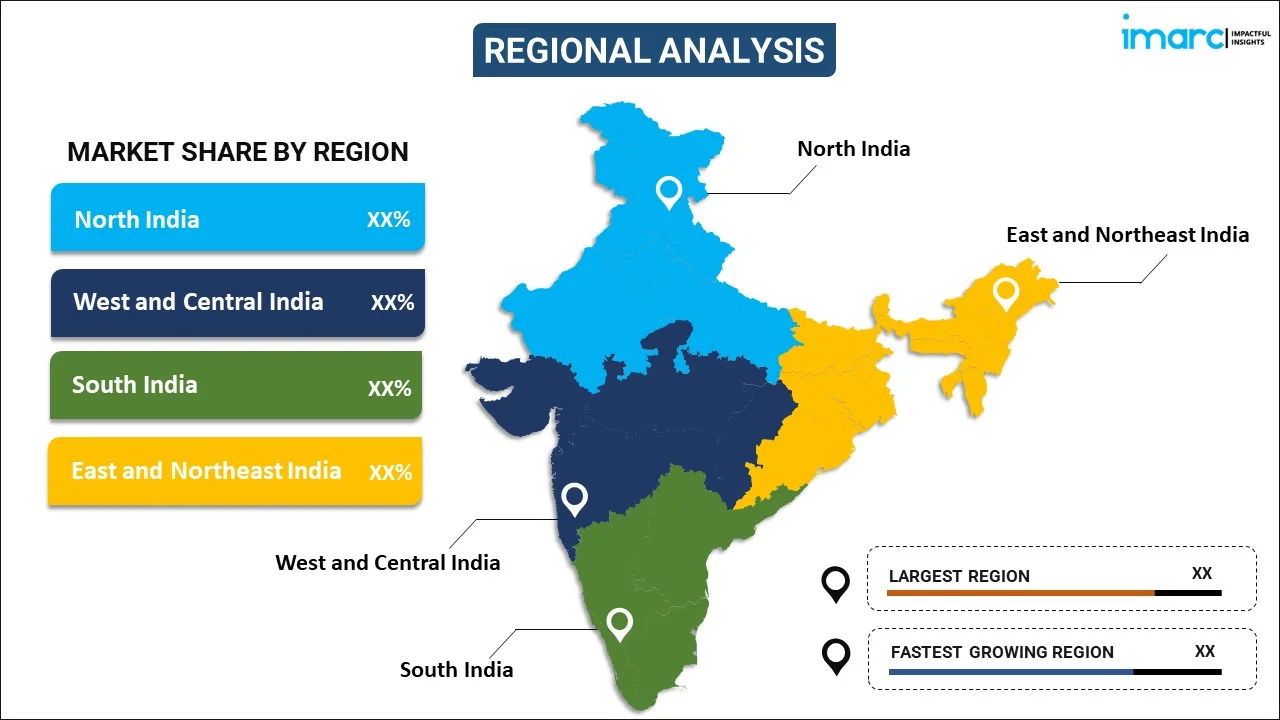
India Facial Recognition Market Report by Component (Software, Services), Technology (2D Facial Recognition, 3D Facial Recognition, Facial Analytics), Application (Emotion Recognition, Attendance Tracking and Monitoring, Access Control, Security and Surveillance, and Others), End Use Industry (Retail and E-commerce, BFSI, Government and Defense, Automotive and Transportation, Media and Entertainment, Healthcare, Telecom and IT, and Others), and Region 2025-2033
Market Overview:
India facial recognition market size reached USD 382.5 Million in 2024. Looking forward, IMARC Group expects the market to reach USD 887.3 Million by 2033, exhibiting a growth rate (CAGR) of 9.4% during 2025-2033. The key players are offering innovative solutions for identity verification, security enhancement, and streamlined processes across various industries, which is among the key factors driving the market growth.
|
Report Attribute
|
Key Statistics
|
|---|---|
|
Base Year
|
2024
|
|
Forecast Years
|
2025-2033
|
|
Historical Years
|
2019-2024
|
|
Market Size in 2024
|
USD 382.5 Million |
|
Market Forecast in 2033
|
USD 887.3 Million |
| Market Growth Rate 2025-2033 | 9.4% |
Facial recognition is a technology designed to recognize human faces in digital images or video frames by comparing them against a database of faces. The process involves multiple steps, including capturing facial features through single images, video sequences, multiple camera views, and three-dimensional (3D) data. The system then analyzes the image by interpreting its geometry and expression before proceeding to recognize and identify the individual. Its primary applications lie in user authentication through identification (ID) verification services and automatic categorization of individuals based on various identifiable features like age, gender, and weight. Additionally, facial recognition has the capability to analyze and accurately identify individuals even in blurred pictures. Its implementation extends to crime prevention, enhancing security efficiency by reducing unnecessary human intervention. The technology finds integration in attendance systems and biometric solutions across sectors such as airport and border control, banking, healthcare, and information technology (IT), contributing to enhanced security and efficiency in diverse applications.
India Facial Recognition Market Trends:
The facial recognition market in India is undergoing rapid growth, fueled by technological advancements, increased digitization, and the integration of facial recognition systems across various sectors. One of the key drivers of the market in this country is its application in authentication and identification services. Crime prevention and enhanced security measures are significant factors contributing to the adoption of facial recognition technology in India. Additionally, by reducing the need for human intervention, facial recognition systems increase the efficiency of security maintenance. These systems are increasingly integrated into public spaces, airports, and border control, providing an additional layer of security. Moreover, the healthcare sector in India is utilizing facial recognition for patient identification, enhancing security and streamlining access to medical records. As the country continues its digital transformation, the facial recognition market is expanding into diverse sectors, including information technology (IT), education, and government services. Government initiatives and regulations are also shaping the adoption of facial recognition technologies, balancing the need for security with privacy considerations. With advancements in machine learning and artificial intelligence, the India facial recognition market is poised for growth in the coming years.
India Facial Recognition Market Segmentation:
IMARC Group provides an analysis of the key trends in each segment of the market, along with forecasts at the country level for 2025-2033. Our report has categorized the market based on component, technology, application, and end use industry.
Component Insights:

- Software
- Services
The report has provided a detailed breakup and analysis of the market based on the component. This includes software and services.
Technology Insights:
- 2D Facial Recognition
- 3D Facial Recognition
- Facial Analytics
A detailed breakup and analysis of the market based on the technology have also been provided in the report. This includes 2D facial recognition, 3D facial recognition, and facial analytics.
Application Insights:
- Emotion Recognition
- Attendance Tracking and Monitoring
- Access Control
- Security and Surveillance
- Others
The report has provided a detailed breakup and analysis of the market based on the application. This includes emotion recognition, attendance tracking and monitoring, access control, security and surveillance, and others.
End Use Industry Insights:
- Retail and E-commerce
- BFSI
- Government and Defense
- Automotive and Transportation
- Media and Entertainment
- Healthcare
- Telecom and IT
- Others
A detailed breakup and analysis of the market based on the end use industry have also been provided in the report. This includes retail and E-commerce, BFSI, government and defense, automotive and transportation, media and entertainment, healthcare, telecom and IT, and others.
Regional Insights:

- North India
- West and Central India
- South India
- East and Northeast India
The report has also provided a comprehensive analysis of all the major regional markets, which include North India, West and Central India, South India, and East and Northeast India.
Competitive Landscape:
The market research report has also provided a comprehensive analysis of the competitive landscape in the market. Competitive analysis such as market structure, key player positioning, top winning strategies, competitive dashboard, and company evaluation quadrant has been covered in the report. Also, detailed profiles of all major companies have been provided.
India Facial Recognition Market Report Coverage:
| Report Features | Details |
|---|---|
| Base Year of the Analysis | 2024 |
| Historical Period | 2019-2024 |
| Forecast Period | 2025-2033 |
| Units | Million USD |
| Scope of the Report | Exploration of Historical Trends and Market Outlook, Industry Catalysts and Challenges, Segment-Wise Historical and Future Market Assessment:
|
| Components Covered | Software, Services |
| Technologies Covered | 2D Facial Recognition, 3D Facial Recognition, Facial Analytics |
| Applications Covered | Emotion Recognition, Attendance Tracking and Monitoring, Access Control, Security and Surveillance, Others |
| End Use Industries Covered | Retail and E-commerce, BFSI, Government and Defense, Automotive and Transportation, Media and Entertainment, Healthcare, Telecom and IT, Others |
| Regions Covered | North India, West and Central India, South India, East and Northeast India |
| Customization Scope | 10% Free Customization |
| Post-Sale Analyst Support | 10-12 Weeks |
| Delivery Format | PDF and Excel through Email (We can also provide the editable version of the report in PPT/Word format on special request) |
Key Questions Answered in This Report:
- How has the India facial recognition market performed so far and how will it perform in the coming years?
- What has been the impact of COVID-19 on the India facial recognition market?
- What is the breakup of the India facial recognition market on the basis of component?
- What is the breakup of the India facial recognition market on the basis of technology?
- What is the breakup of the India facial recognition market on the basis of application?
- What is the breakup of the India facial recognition market on the basis of end use industry?
- What are the various stages in the value chain of the India facial recognition market?
- What are the key driving factors and challenges in the India facial recognition?
- What is the structure of the India facial recognition market and who are the key players?
- What is the degree of competition in the India facial recognition market?
Key Benefits for Stakeholders:
- IMARC’s industry report offers a comprehensive quantitative analysis of various market segments, historical and current market trends, market forecasts, and dynamics of the India facial recognition market from 2019-2033.
- The research report provides the latest information on the market drivers, challenges, and opportunities in the India facial recognition market.
- Porter's five forces analysis assist stakeholders in assessing the impact of new entrants, competitive rivalry, supplier power, buyer power, and the threat of substitution. It helps stakeholders to analyze the level of competition within the India facial recognition industry and its attractiveness.
- Competitive landscape allows stakeholders to understand their competitive environment and provides an insight into the current positions of key players in the market.
Need more help?
- Speak to our experienced analysts for insights on the current market scenarios.
- Include additional segments and countries to customize the report as per your requirement.
- Gain an unparalleled competitive advantage in your domain by understanding how to utilize the report and positively impacting your operations and revenue.
- For further assistance, please connect with our analysts.
 Inquire Before Buying
Inquire Before Buying
 Speak to an Analyst
Speak to an Analyst
 Request Brochure
Request Brochure
 Request Customization
Request Customization




.webp)




.webp)












